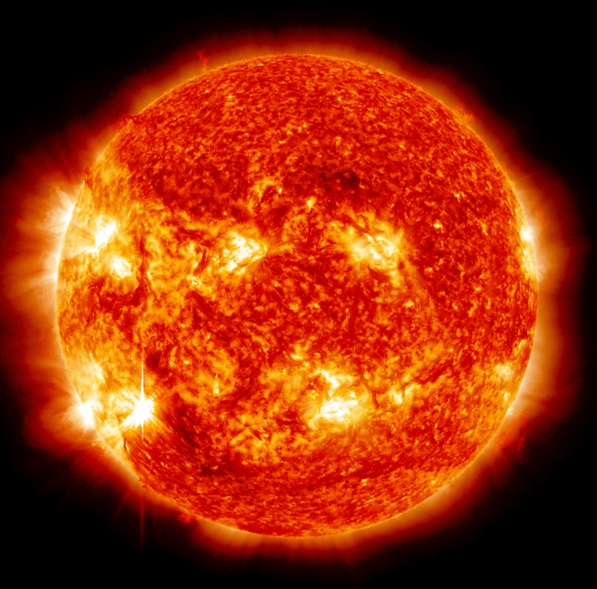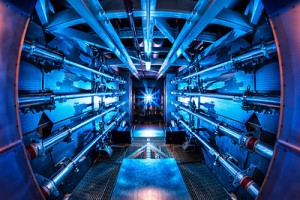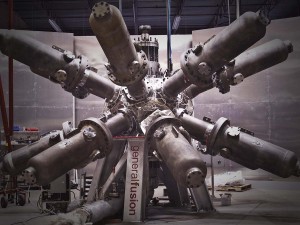Nuclear fusion is awesome.
It’s about time I did a blog post on fusion – I’ll jump straight into it.
Nuclear fusion is the reaction in which two smaller atoms fuse together and make one bigger atom. The best example of this process is right above our heads (or below your feet, depending on the time). All the stars in the universe, including our very own Sun, are essentially nuclear fusion engines. In these grand stellar furnaces, their ridiculously huge mass results in an intense gravitational field. Because of gravity, stars squish themselves to such intense pressures and temperatures that hydrogen atoms get close enough to fuse, allowing the star to burn for billions of years. Releasing an enormous amount of energy in the process as described by $$E=mc^2$$.

Now the curious reader might ask, “How does nuclear fusion produce energy anyway?” Well, the reason nuclear fusion releases energy is actually rather interesting and unintuitive. It’s kinda funky physics when you think about it.
So pretend you have two blobs of playdough. Since it’s playdough, you don’t have to bother with gravity or fancy magnets and lasers, your hands will work. Smash these two blobs of playdough into one big blob of playdough. Now this new, bigger blob of playdough should weigh the same as the weights of the two original blobs added together, right? Well, it turns out atoms don’t quite behave like playdough.
If you smash two hydrogen atoms together to make a helium atom, the helium atom doesn’t actually have the same mass as the two hydrogens added together. The new helium atom weighs less than the sum of its parts.
Huh?
Now how can this be? Well it turns out that all atoms are held together by some force – the nuclear strong force. It explains why protons (which are positive) in an atom don’t all fly apart from their magnetic repulsion. It’s the force that keeps atoms bound together (which is rather useful). This energy also has mass, because remember; $$E=mc^2$$. Or more specifically, $$m=\frac{E}{c^2}$$ – the mass of the binding energy is equal to the energy divided by the speed of light squared. This is a really small mass, since you’re dividing the energy by $$c^2$$ – an unfathomably large number.
Yeah, Einstein’s equation doesn’t just sound cool, it’s useful too.

You can apply Einstein’s equation to a nuclear fusion reaction like the one shown below. Find the mass of the things your fusing, the mass of what you end up with and the difference is how much energy you get out. Pretty neat. What that calculation means is that when you fuse two hydrogen atoms into a helium atom, some of that “mass-energy” gets flung out as heat, light and radiation.
Thanks to nuclear fusion and the so called “mass defect”, the Sun emits light and energy; transmitting it to our otherwise cold and desolate planet. Pretty much all the energy stored on Earth – as chemical, electrical, kinetic etc… all of it can be traced back to the nuclear fusion engine that we orbit around. Pretty neat. It’s also why some eloquently versed scientists sometimes say that “we’re made of star dust” – which is true, but a whole other story of stars getting old, cranky and inevitably exploding.
So fusion releases a whole load of energy – more than fission (splitting the atom). So wouldn’t it be cool if we could do fusion on Earth and generate electricity from that? Well, taming the beast that is fusion is exceptionally tricky. If Derek Muller described nuclear fission as a “dragon” in his recent documentary, “Uranium”, then I think we can describe fusion as the GodzillaMonsterOfDoomFromOuterSpace. Fusion is really damn hard.
Sidenote: A friendly godzilla monster, that is. Fusion is inherently super duper safe and environmentally friendly.
Many Ways to Bottle A Star
Fusion plasma is really hot – hundreds millions of degrees Celsius, in fact. Now don’t give me any of that cold fusion rubbish – I could write a whole blog post or two about that disaster. Fusion only happens at the hottest imaginable temperatures (or high velocity, depending on how you look at it). Since superheated plasma is…well…super-hot, you can’t physically contain it. No material can survive direct contact with something hotter than the sun…so how the heck do you achieve fusion on Earth and contain it?
Magnets, of course!
Well…that’s one way if you’re doing thermonuclear magnetic confinement fusion, that is. There’s actually over 20 different ways to achieve fusion, ranging from DIY tabletop devices to 20 storey, multi-billion dollar international collaborations like ITER (International Thermonuclear Experimental Reactor). Magnets are arguably the best way to go about fusion though. Of course they are – magnets are cool. But, to be fair, there are other very fascinating ways to achieve fusion. Some of which are particularly promising. Below are four examples of fusion machines (top left is the magnet one).
Evidently, there are many ways to harness the GodzillaMonsterOfDoomFromOuterSpace, also known as fusion. And yes, before you ask, the one of the bottom left with the massive hammers is actually a thing.
“But how do you get energy out of these miracle machines?”, you ask? Oh you know, neutrons heating things up, and boiling water to turn a turbine. Direct energy conversion is another method, thanks to alpha particles. More on that later.
Stay tuned! I’ll be blogging about some of my favourite fusion technologies like the plasma doughnuts, Star Trek Laser Thing, tabletop teenage experiments and of course, hammer time.
-A




Leave a Reply